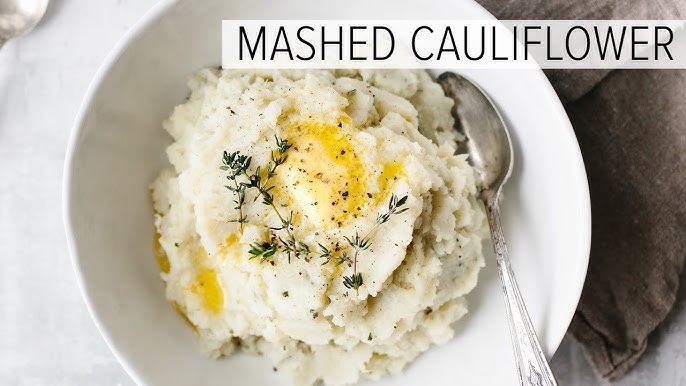Mashed Cauliflower Recipe: If you’re looking for a delicious, low-carb alternative to traditional mashed potatoes, you’re in the right place. Mashed cauliflower has become a go-to favorite in health-conscious kitchens, offering a creamy, comforting dish that satisfies cravings without the heaviness.
Whether you’re following a keto, paleo, or gluten-free diet—or just want to try something new—mashed cauliflower is an absolute game-changer. It’s smooth, flavorful, and surprisingly easy to whip up.
Why Mashed Cauliflower is a Great Alternative
Let’s face it: mashed potatoes are a comfort food classic. But they’re also loaded with carbs, and for those watching their sugar or calorie intake, that can be a problem. Enter mashed cauliflower—a vegetable dish that mimics the texture and feel of mashed potatoes but brings a lighter nutritional profile. It’s not only delicious, but it’s also versatile and quick to make.
What makes mashed cauliflower stand out is its ability to soak up flavors. You can customize it with garlic, herbs, cheese, or even a touch of butter or cream cheese. It goes perfectly with just about any protein: think grilled chicken, steak, baked fish, or even holiday roasts. Plus, it gives your meal a gourmet touch without the extra effort.
Mashed cauliflower has gained immense popularity not just for dietary reasons, but because it actually tastes good. It’s not just a compromise—it’s a solid side dish that holds its own.
Benefits of Cauliflower Over Potatoes
So, why swap out spuds for florets? For starters, cauliflower is much lower in carbs. One cup of cooked cauliflower contains just 5 grams of carbs, while the same amount of mashed potatoes can pack over 30 grams. That’s a massive difference, especially for those on carb-restricted diets.
Cauliflower is also loaded with nutrients. It’s a great source of fiber, vitamin C, vitamin K, and antioxidants. It supports digestion, fights inflammation, and even has cancer-fighting properties thanks to compounds like sulforaphane.
On the glycemic index, cauliflower ranks much lower than potatoes, meaning it won’t spike your blood sugar as dramatically. That makes it a smarter choice for people with diabetes or insulin resistance.
Lastly, it’s incredibly filling. The fiber content in cauliflower helps you feel full longer, which can aid in weight management and reduce the urge to snack between meals. So next time you’re craving something rich and creamy, remember that cauliflower isn’t just the healthy choice—it’s the delicious one too.
Ingredients You’ll Need
Before we dive into cooking, let’s get your ingredients lined up. The beauty of mashed cauliflower is its simplicity. You only need a few basics, and you might already have most of them in your kitchen.
Fresh Cauliflower Selection Tips
First things first—start with a good head of cauliflower. When buying fresh cauliflower, look for one that’s firm, tightly packed, and white or creamy in color. Avoid heads with brown spots, soft patches, or signs of wilting. The leaves around the base should be green and crisp, indicating freshness.
You’ll need one medium head of cauliflower for about 3–4 servings. If you’re cooking for a bigger crowd, double up. For convenience, you can also use pre-cut florets or even frozen cauliflower, though fresh typically yields a better texture.
Essential Ingredients List:
- 1 medium head of cauliflower
- 2 tablespoons of butter (or ghee for dairy-free)
- 2 cloves of garlic (optional, for flavor)
- Salt and pepper to taste
- 2 tablespoons of cream cheese or sour cream (optional for creaminess)
- Fresh chives or parsley (for garnish)
Optional Add-ins for Extra Flavor
Want to spice things up? Here are some optional but delicious add-ins to elevate your mash:
- Roasted garlic: Swap raw garlic with roasted cloves for a mellow, sweet flavor.
- Grated parmesan cheese: Adds a savory, nutty richness.
- Fresh herbs: Rosemary, thyme, or dill add earthy undertones.
- Spices: A pinch of paprika or nutmeg can bring depth.
- Truffle oil: Just a drizzle gives it a luxurious twist.
The beauty of this dish is how customizable it is. You can keep it simple for everyday meals or dress it up for special occasions. Either way, the result will be satisfying.
Tools and Equipment
Making mashed cauliflower doesn’t require a lot of fancy gadgets. In fact, you can get by with just a few basic kitchen tools. But if you want to streamline the process or take your texture to the next level, some additional equipment can help.
Kitchen Essentials for the Recipe
At a minimum, you’ll need the following:
- Cutting board and knife: To break down the cauliflower into florets.
- Large pot or steamer: For cooking the cauliflower.
- Colander or strainer: To drain the water after boiling or steaming.
- Blender, food processor, or potato masher: To mash the cauliflower.
- Mixing bowl and spoon: For stirring in seasonings and serving.
These are standard tools in most kitchens, so chances are, you’re already equipped. The key is making sure the cauliflower is cooked and drained well so the final mash isn’t watery.
Handy Gadgets That Make It Easier
If you’re a gadget lover or plan to make mashed cauliflower often, here are a few tools that can make life easier:
- Immersion blender: Quick, easy to clean, and blends directly in the pot.
- Food processor: Produces the smoothest texture.
- Steamer basket: Keeps cauliflower from getting waterlogged.
- Garlic press: For easily adding fresh garlic.
While not essential, these tools help speed things up and improve consistency. The smoother the mash, the more convincing the texture will be—especially for those skeptical about ditching potatoes.
How to Make Mashed Cauliflower – Step by Step Guide
Getting the perfect mashed cauliflower starts with nailing each step. If you rush the process or skip the small details, you might end up with a watery or bland mash. But don’t worry—I’ve got you covered with this foolproof, step-by-step guide.
Step 1: Wash and Cut the Cauliflower
Start by removing the outer leaves of the cauliflower head. Give the entire head a thorough rinse under cool running water to remove any dirt or debris. Next, place the cauliflower on a cutting board and use a sharp knife to trim off the stem and break the head into evenly sized florets.
Uniform size matters because it ensures even cooking. Too large and some pieces might be undercooked; too small and they could get mushy. Aim for medium-sized florets that are about the size of a golf ball.
Pro Tip: If you’re using pre-cut cauliflower, give it a quick rinse and double-check for freshness. Fresh florets will feel firm and have no unpleasant odor.
Step 2: Boil or Steam to Perfection
Now it’s time to cook the cauliflower. You have two great options here—boiling or steaming. Each has its pros:
- Boiling: This is quicker and more common. Just place the florets in a large pot of salted boiling water and cook for 8–10 minutes, or until fork-tender.
- Steaming: Steaming helps retain more nutrients and reduces water content, making the mash less watery. Steam for about 10–12 minutes until tender.
Regardless of the method, the goal is to get the cauliflower soft enough to mash easily but not so overcooked that it falls apart or becomes waterlogged.
Test doneness by poking a fork into the largest floret. If it slides in easily, you’re good to go.
Step 3: Drain and Dry Properly
Here’s where most people mess up: they don’t dry the cauliflower well enough. Excess water is your enemy here—it’ll ruin the texture of your mash and make it soupy.
Once cooked, transfer the cauliflower to a colander and let it drain for a few minutes. Then, spread it out on a clean kitchen towel or paper towels and gently pat it dry. If you want to be extra cautious, let it sit for another 5 minutes to air-dry a bit more.
You can also return the drained cauliflower to the hot pot and let it sit over low heat for 2–3 minutes. Stir occasionally to evaporate residual moisture.
Trust me—this one step can mean the difference between a soggy mash and a thick, creamy masterpiece.
Step 4: Mash It Up – Different Methods
Now comes the fun part—mashing! Depending on the tools you have and the texture you prefer, there are a few different ways to do this:
- Immersion Blender: Gives the smoothest, silkiest mash with minimal effort.
- Food Processor: Also yields a smooth texture but can over-process if you’re not careful.
- Hand Masher: Perfect if you like a bit of texture or don’t have fancy gadgets.
- Fork: Good in a pinch but can be a workout!
Add the cooked cauliflower to your chosen mashing device or mixing bowl. Then, add your butter, garlic (if using), and any other flavorings like cream cheese, herbs, or parmesan. Blend or mash until you reach your desired consistency—smooth, fluffy, and lump-free.
Want ultra-creamy mash? Add a splash of milk or chicken broth. Go slowly—you can always add more, but you can’t take it out once it’s in.
Step 5: Add Seasoning and Final Touches
Taste time! Now that your cauliflower is mashed and creamy, it’s time to season it to perfection.
Start with the basics:
- Salt and black pepper to taste
- A knob of butter or a swirl of olive oil for richness
- Chopped chives or parsley for freshness
Want to make it extra special? Stir in roasted garlic, grated cheese, or even a pinch of truffle salt for a gourmet twist.
Serve your mashed cauliflower hot, right off the stove. It pairs beautifully with everything from seared steak to roasted veggies to grilled chicken. Add it to your dinner rotation, and don’t be surprised when it becomes a weeknight favorite.
Tips for Perfect Mashed Cauliflower
Getting it just right takes more than following a recipe—it’s about knowing a few tricks of the trade. Here are some must-know tips to elevate your mashed cauliflower game.
Avoiding Watery Mash
We’ve said it before, but it’s worth repeating: water is the enemy. Cauliflower naturally holds moisture, and if you don’t remove enough of it, you’ll end up with a soupy, sad mess. Here’s how to avoid it:
- Always drain thoroughly after boiling or steaming.
- Let the cauliflower sit in the pot over low heat to steam off extra moisture.
- Use a kitchen towel to press out any lingering water before mashing.
Another common mistake is adding too much liquid too soon. Add your butter, cream cheese, or milk in small increments, tasting and checking the texture as you go. You can always add more, but fixing watery mash is nearly impossible.
Achieving Creamy Texture Without Cream
Don’t want to use cream or dairy? No problem. You can still achieve a rich, luxurious texture with a few plant-based swaps:
- Use cashew cream or almond milk for dairy-free creaminess.
- Add a tablespoon of olive oil or vegan butter.
- Blend with nutritional yeast for a cheesy flavor without dairy.
Another trick? Use a food processor to blitz your cauliflower into a whipped, cloud-like consistency. The key is patience—don’t rush the blending process. The longer you blend (within reason), the creamier it gets.
Want a flavor boost? Try adding sautéed onions or a teaspoon of Dijon mustard to the mash. It adds a subtle complexity that keeps things interesting.
Flavor Variations
Mashed cauliflower is like a blank canvas—it welcomes all kinds of flavors and textures. Whether you’re feeling bold or just want to spice things up for a change, here are some fun and delicious ways to switch it up.
Garlic and Herb Mashed Cauliflower
If you love bold, aromatic flavors, this variation is for you. Garlic and herbs elevate the taste of cauliflower mash, turning it into something restaurant-worthy.
Ingredients You’ll Need:
- 1–2 cloves of roasted garlic (or sautéed for milder flavor)
- Fresh herbs like parsley, thyme, or rosemary
- Olive oil or melted butter
- Salt and pepper to taste
How to Make It: Simply follow the original mashed cauliflower recipe but add the garlic during the mashing process. Roasting the garlic beforehand mellows out its flavor and brings a slight sweetness. Stir in freshly chopped herbs at the end for a pop of color and flavor.
This version pairs amazingly well with grilled meats or roasted vegetables, giving a rustic, herby flair to your meal. You’ll love how the garlic subtly infuses each bite without overpowering the natural taste of cauliflower.
Cheesy Cauliflower Mash
Cheese lovers, this one’s for you. Adding cheese to your mash not only boosts flavor but also enhances the creamy texture.
Best Cheeses to Use:
- Parmesan: for a nutty, savory taste
- Cheddar: for a rich, bold flavor
- Cream cheese: for added creaminess and tang
- Mozzarella: for a stretchy, smooth texture
Pro Tip: Combine two or three types for a more complex flavor profile.
How to Make It: After mashing the cauliflower, stir in your cheese of choice while the mash is still hot. It’ll melt right in, creating a gooey, decadent dish that’s hard to resist.
Add a sprinkle of smoked paprika or black pepper on top for that extra oomph. Serve with grilled chicken or meatloaf for a comforting, cheesy meal that satisfies every craving.
Nutritional Information
One of the best parts about mashed cauliflower is how healthy it is. Whether you’re on a diet or just looking to eat better, this dish delivers both flavor and nutrition.
Nutrition Breakdown (per 1-cup serving)
| Nutrient | Amount |
|---|---|
| Calories | 90–120 kcal (depends on add-ins) |
| Carbohydrates | 5–7 grams |
| Protein | 2–3 grams |
| Fat | 7–10 grams |
| Fiber | 2–3 grams |
| Vitamin C | 45% of Daily Value |
| Calcium | 3–5% of Daily Value |
| Iron | 2–3% of Daily Value |
These numbers may vary based on the ingredients you use—especially if you add cheese or cream. But even with rich add-ins, mashed cauliflower remains lower in carbs and calories compared to traditional mashed potatoes.
It’s a great choice for keto, low-carb, gluten-free, and diabetic-friendly diets.
Serving Suggestions
Now that you’ve got a bowl of warm, creamy mashed cauliflower, what do you pair it with? Here are some top-notch serving suggestions to make your meal complete:
Protein Pairings:
- Grilled steak or chicken: A classic combo, great for high-protein, low-carb dinners.
- Baked salmon: The richness of the fish pairs beautifully with the light, herby mash.
- Slow-cooked beef or pot roast: Mashed cauliflower soaks up the juices perfectly.
Veggie Additions:
- Roasted Brussels sprouts
- Sautéed spinach with garlic
- Caramelized onions
Make It a Bowl:
Create a layered bowl meal by topping your mash with:
- Grilled veggies
- Shredded rotisserie chicken
- A fried or poached egg
- A drizzle of tahini or hot sauce
Mashed cauliflower is more than just a side dish—it can be the star of your plate. Get creative, mix things up, and enjoy a meal that feels indulgent but is actually good for you.
Common Mistakes to Avoid
Even though mashed cauliflower is easy to make, a few common mistakes can trip you up. Here’s what to look out for:
1. Not Draining Properly
We’ve said it before, but it’s worth repeating—drain that cauliflower! Skipping this step leads to a soggy, watery mess that tastes bland and lacks texture.
2. Overcooking the Cauliflower
Too-soft cauliflower becomes mushy and can break apart into water. Aim for tender, not overcooked.
3. Skipping Flavor Enhancers
Cauliflower is mild, so it needs seasoning. Don’t forget the salt, pepper, garlic, herbs, or cheese—whatever matches your taste buds.
4. Using Too Much Liquid
Add milk, broth, or cream in small amounts. A little goes a long way, and once it’s too runny, there’s no turning back.
5. Blending Too Much
While a food processor gives a smooth texture, over-processing can turn it gluey. Blend just until smooth and creamy—no more.
By avoiding these mistakes, you’ll get perfect mashed cauliflower every time, no matter your experience in the kitchen.
Storage and Reheating Tips
Made a big batch and wondering what to do with the leftovers? Good news: mashed cauliflower stores and reheats beautifully—if you do it right. Let’s break down how to keep it fresh and flavorful for days.
Storing Mashed Cauliflower
After your mashed cauliflower has cooled to room temperature, transfer it into an airtight container. Make sure the container seals tightly to prevent it from absorbing odors from the fridge.
- Refrigerator: Mashed cauliflower stays fresh in the fridge for up to 4 days. Just give it a quick stir before reheating, as it may separate slightly during storage.
- Freezer: Yes, you can freeze mashed cauliflower! Portion it into freezer-safe containers or resealable bags. Flatten the bags for easier storage and faster thawing. It can last up to 2 months in the freezer.
Pro Tip: Label the containers with the date so you don’t forget how long it’s been in there.
Reheating Mashed Cauliflower
When it’s time to reheat, be gentle. High heat can change the texture and make it gummy.
Best methods:
- Microwave: Heat in 30-second intervals, stirring each time to prevent uneven heating.
- Stovetop: Place in a nonstick saucepan over low to medium heat. Stir often and add a splash of milk or broth if it’s too thick.
- Oven: Preheat to 350°F, place mash in an oven-safe dish, cover with foil, and heat for 15–20 minutes.
Avoid reheating more than once. Only warm up what you plan to eat to keep the texture and flavor intact.
FAQs about Mashed Cauliflower Recipe
What is mashed cauliflower?
Mashed cauliflower is a healthy alternative to traditional mashed potatoes. Made from steamed or boiled cauliflower that’s been pureed or mashed, it offers a similar texture with fewer carbohydrates and calories.
Is mashed cauliflower keto-friendly?
Yes, mashed cauliflower is perfect for a keto diet as it is low in carbs and can be enriched with keto-friendly ingredients like cheese, butter, or cream.
How can I make mashed cauliflower creamy?
To make your mashed cauliflower creamy, add ingredients like cream cheese, sour cream, or a splash of heavy cream. Blending the cauliflower while it’s still warm will also help achieve a smoother texture.
Can I make mashed cauliflower without a food processor?
Absolutely! You can use a potato masher or even a fork to mash the cauliflower. The texture will be chunkier but still delicious.
What can I add to mashed cauliflower for more flavor?
Enhance the flavor of your mashed cauliflower by adding garlic, cheese, chives, or bacon bits. Spices such as paprika or black pepper also work well.
Is mashed cauliflower suitable for freezing?
Yes, mashed cauliflower can be frozen for up to three months. Thaw it in the refrigerator overnight and reheat it on the stove or in the microwave, adding a little butter or cream to refresh the texture.
Can mashed cauliflower be made in advance?
Certainly! Prepare it a day ahead and store it in the refrigerator. Reheat it in a saucepan over low heat, stirring occasionally, until it’s warm throughout.
Are there any variations of mashed cauliflower I can try?
There are many variations! Try mixing in roasted garlic, turning it into a cheesy bake with parmesan, or adding curry spices for a unique twist.
What are the health benefits of mashed cauliflower?
Mashed cauliflower is high in vitamins C and K, fiber, and antioxidants. It’s also lower in calories than mashed potatoes, making it a great option for those watching their calorie intake.
Conclusion
There you have it—your ultimate step-by-step guide to making the perfect mashed cauliflower. Whether you’re cutting carbs, embracing clean eating, or just looking for a tasty new side dish, this recipe has got your back. It’s rich, creamy, and packed with flavor, yet light enough to fit into any diet plan.
Mashed cauliflower isn’t just a substitute for mashed potatoes—it’s a star in its own right. With endless flavor variations, health benefits, and easy prep, it’s a dish you’ll want to return to again and again. So grab a head of cauliflower, fire up your stove, and get mashing!
Once you try it, you’ll see exactly why this humble veggie mash has earned a permanent spot on dinner tables around the world.



